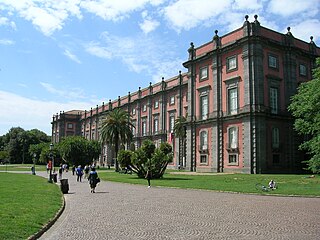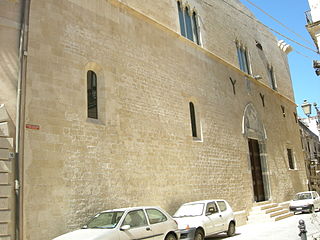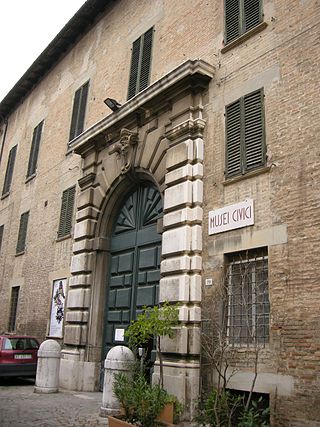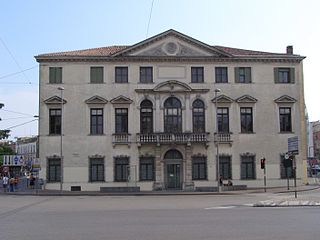
Luca Giordano was an Italian late-Baroque painter and printmaker in etching. Fluent and decorative, he worked successfully in Naples, Rome, Florence, and Venice, before spending a decade in Spain.

Ca' Rezzonico is a palazzo and art museum on the Grand Canal in the Dorsoduro sestiere of Venice, Italy. It is a particularly notable example of the 18th century Venetian baroque and rococo architecture and interior decoration, and displays paintings by the leading Venetian painters of the period, including Francesco Guardi and Giambattista Tiepolo. It is a public museum dedicated to 18th-century Venice and one of the 11 venues managed by the Fondazione Musei Civici di Venezia.

The Galleria Nazionale d'Arte Moderna e Contemporanea, also known as La Galleria Nazionale, is an art gallery in Rome, Italy. It was founded in 1883 on the initiative of the then Minister Guido Baccelli and is dedicated to modern and contemporary art.

Palazzo Farnese is a palace in Piacenza, northern Italy.

Palazzo Mozzi or Palazzo de' Mozzi is an early Renaissance palace, located at the end of the Piazza de' Mozzi that emerges from Ponte alle Grazie and leads straight to the palace where via San Niccolò becomes via de' Bardi in the Quartiere of Santo Spirito in the Oltrarno section of Florence, region of Tuscany, Italy. The 13th-century palace housed the gallery of the highly successful antiquarian Stefano Bardini, of which the remnants were left to the commune, where they assembled the Museo Bardini or Mozzi Bardini, displaying Florentine art and artifacts up to the early Renaissance. The gardens elaborated against the hillside behind the palace were added mainly by Bardini.

The Ca' Pesaro is a Baroque marble palace turned art museum, facing the Grand Canal of Venice, Italy. Today it is one of the 11 museums run by the Fondazione Musei Civici di Venezia system.

The Museo Correr is a museum in Venice, northern Italy. Located in St. Mark's Square, Venice, it is one of the 11 civic museums run by the Fondazione Musei Civici di Venezia. The museum extends along the southside of the square on the upper floors of the Procuratorie Nuove. With its rich and varied collections, the Museo Correr covers both the art and history of Venice.

Palazzo dei Diamanti is a Renaissance palace located on Corso Ercole I d'Este 21 in Ferrara, region of Emilia Romagna, Italy. The main floor of the Palace houses the Pinacoteca Nazionale di Ferrara.

The Royal Palace of Capodimonte is a large palazzo in Naples, Italy. It was formerly the summer residence and hunting lodge of the Bourbon kings of the Two Sicilies, one of the two royal palaces in Naples. Today, it comprises the National Museum of Capodimonte and the Royal Forest. The palace was constructed on its somewhat cooler hilltop location just outside the city, with urban Naples ultimately expanding around it.

The Museum of Mexico City is located at Pino Suarez 30, a few blocks south of the Zocalo, on what was the Iztapalapa Causeway, near where Hernán Cortés and Moctezuma II met for the first time. This building used to be the palace of the Counts of Santiago de Calimaya, who were the descendants of one of the conquistadors with Cortés. The house was extensively remodeled during the colony to much the appearance that it has today and remained in the family until 1960, when the Mexico City government acquired it from them in order to found the Museum that is found there today. The museum contains a number of elements of the old palace as well as 26 rooms dedicated to the history and development of Mexico City from Aztec times to the present. It also contains a library and the studios of painter Joaquín Clausell, who lived here in the late 19th and early 20th centuries.

The Palazzo Comunale, also known as the Palazzo del Popolo of San Gimignano has been the seat of the civic authority in the comune since the 13th century. It is located on the Piazza del Duomo close to the Collegiate Church of the Assumption of the Blessed Virgin Mary. The building and Collegiate Church are at the heart of the medieval town, and are part of the UNESCO World Heritage Site of the "Historic Centre of San Gimignano".

The National Museum of Ceramics and Decorative Arts "González Martí", located in Valencia, Spain, is a museum dedicated to ceramics, porcelains and other decorative arts such as textile art, traditional costumes and furniture.

The Museo di Roma is a museum in Rome, Italy, part of the network of Roman civic museums. The museum was founded in the Fascist era with the aim of documenting the local history and traditions of the "old Rome" that was rapidly disappearing, but following many donations and acquisitions of works of art is now principally an art museum. The collections initially included 120 water-colours by the nineteenth-century painter Ettore Roesler Franz of Roma sparita, "vanished Rome", later moved to the Museo di Roma in Trastevere.
The Diocesan museum of Padua displays arts and artifacts belonging to the Roman Catholic Diocese of Padua; it is housed in the 15th-century former bishop's residence or Palazzo Vescovile. The building, adjacent to the Cathedral of Padua, faces the Piazza del Duomo, can in the historic center of Padua, region of Veneto, Italy.

Bellomo Palace Regional Gallery is an art museum in Syracuse, Sicily.

The Palazzo San Sebastiano is a 16th-century palace in Mantua. Built by the Gonzaga family, since 19 March 2005 it has housed Mantua's city museum.

The Civic Museum of Palazzo Mosca is the main civic museum of Pesaro, displaying art and decorative works, located in Piazza Mosca in this town of the region of the Marche, Italy.

The Palazzo Cavalli alle Porte Contarine, also called the Palazzo Cavalli agli Eremitani is a Renaissance-style palace located at the intersection of Corso Giuseppe Garibaldi and Via Giacomo Matteotti in Padua, region of Veneto, Italy. In 2019, it is owned by the University of Padua and houses the university's collections of geology and paleontology in the Museo della Natura e dell’Uomo.

The Turin Civic Gallery of Modern and Contemporary Art is an art gallery in Turin, Italy, founded in 1891-1895 and located in 31 via Magenta. With the MAO, Palazzo Madama e Casaforte degli Acaja, the Borgo and the Rocca medioevali, it forms part of the Fondazione Torino Musei. The lower rooms house important reviews and a large collection of video art.


















